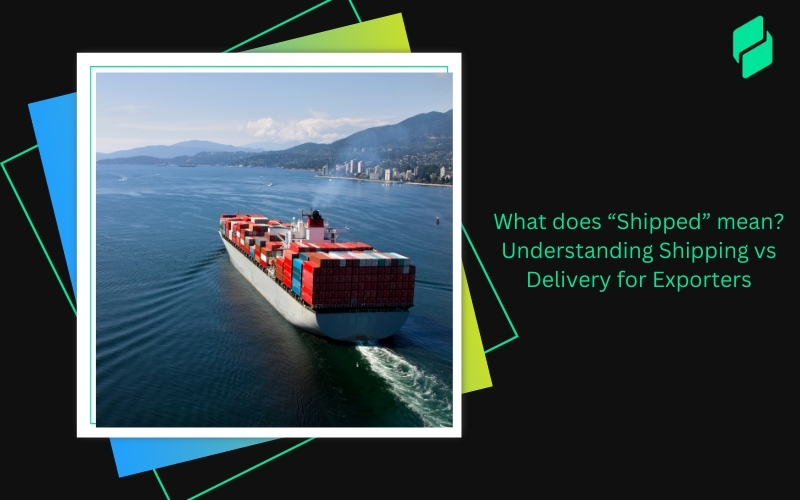Optimize your business: use unlimited savings with Pazago fulfilled now!
Get Started ->Did you know that more than 80% of global trade is transported by sea? This immense volume of goods moves across the world’s oceans daily, making maritime freight transport a crucial element of international trade. For Indian exporters, understanding the ins and outs of marine shipping is essential to staying competitive in the global market.
In this blog, we’ll break down the types and characteristics of maritime freight transport, explore the challenges it brings, and show how platforms like Pazago can simplify the process for exporters. Keep reading to discover how maritime transport can work for your business.
What is Maritime Transport and Why Choose It?

Maritime transport is the process of moving goods by ship across oceans, seas, and other waterways. It's the most widely used form of global trade transport, connecting countries and continents. For Indian exporters, maritime shipping is a vital link to international markets, ensuring that goods such as textiles, electronics, and agricultural products can reach consumers worldwide.
Why Choose Maritime Transport?
- Cost-Effectiveness: Shipping large volumes of goods by sea is usually more affordable than other transportation methods, particularly when it comes to bulk items.
- Large Capacity: Ships can carry vast amounts of goods, making it ideal for exporters with large volumes of cargo, such as agricultural products or manufactured goods.
- Global Reach: With major ports connecting countries globally, maritime transport opens up a world of export opportunities for Indian businesses.
- Versatility: No matter if you're sending raw materials, machinery, or finished goods, maritime transport is capable of handling all kinds of cargo, making it a versatile choice for different industries.
Now that we understand what maritime transport is and why it's a preferred choice, let's explore the key characteristics that make it stand out.
Also Read: Understanding Ocean Transport: Maritime and Bulk Freight Shipping
Key Characteristics of Maritime Freight Transport

Maritime freight transport plays a vital role in global trade, moving goods efficiently across continents. With its ability to handle diverse cargo types and adapt to different shipping needs, it remains a preferred choice for businesses worldwide. Here are some key characteristics that define maritime freight transport.
- Reliability in Long-Distance Shipping
Unlike other transportation modes, shipping by sea is less affected by traffic congestion or weather disruptions. Modern vessels follow established shipping lanes and schedules, ensuring consistent and predictable deliveries, even over long distances.
- Sustainability and Lower Carbon Footprint
Compared to air and road transport, maritime shipping produces significantly lower emissions per ton of cargo moved. Advancements in fuel efficiency and alternative energy sources, such as LNG and wind-assisted propulsion, are making ocean transport even more environmentally friendly.
- Ability to Handle Specialized Cargo
Certain goods require specific storage conditions, such as temperature control, humidity regulation, or extra security. Maritime freight transport includes specialized vessels like refrigerated (reefer) ships, tankers, and RO-RO (roll-on/roll-off) ships for vehicles, making it adaptable to different industry needs.
- Importance of Port Infrastructure and Connectivity
Efficient maritime transport depends on well-equipped ports with advanced loading, unloading, and storage facilities. Ports serve as critical hubs, linking sea routes with inland transportation networks such as rail and road, ensuring smooth cargo movement from ship to final destination.
- Influence of International Regulations and Safety Standards
Maritime shipping operates under strict international laws, ensuring cargo security and environmental responsibility. Organizations like the International Maritime Organization (IMO) regulate vessel safety, pollution control, and shipping protocols, making global trade safer and more standardized.
Now that we've highlighted the key traits of maritime shipping, let's break down the various types of vessels used for different cargo needs.
Also Read: International Freight Shipping: Definition And Key Stages - Pazago
Types of Maritime Freight Transport

There are several types of ships used in maritime freight transport, each designed to carry specific types of cargo. Understanding the differences between them is essential for Indian exporters to choose the best shipping option based on their products.
- Bulk Carriers: These ships are designed to carry unpackaged bulk goods such as coal, iron ore, grains, and cement. For Indian exporters, bulk carriers are particularly relevant for the transportation of resources like coal and minerals, which are vital to global industries.
- Container Ships: These are the most common ships used for international trade and are designed to carry standardized containers. They're ideal for shipping goods like electronics, textiles, and machinery, which are commonly exported from India. Container ships offer flexibility and efficiency, making them perfect for smaller, more diverse shipments.
- Tankers: Tankers are designed to carry liquid cargoes, including crude oil, chemicals, and liquefied natural gas (LNG). India is one of the largest importers of crude oil, and many Indian exporters rely on tankers to import raw materials and chemicals, making this type of transport critical for the country's economy.
- General Cargo Ships: These ships can carry a wide variety of goods, and they often use cranes to load and unload cargo. They are versatile and are used for products that may not fit into containers or need special handling. Indian exporters in industries like textiles and auto parts often use general cargo ships to ship their products.
- Roll-on/Roll-off (Ro-Ro) Ships: Ro-Ro ships are built to transport vehicles like cars, trucks, and machinery that can be driven straight onto and off the ship. For India's automobile industry, Ro-Ro ships are essential for transporting vehicles to international markets, especially to the Middle East and Africa.
While each type of vessel has its strengths, there are several challenges that exporters must consider when choosing maritime freight.
Also Read: Understanding Common International Shipping Terms
Challenges in Maritime Freight Transport

While maritime freight offers several advantages, it's not without its challenges. Indian exporters must be aware of these issues to better prepare and mitigate potential risks in their shipping processes.
- Delays and Port Congestion: High traffic at major ports can lead to delays, especially during peak seasons. This can disrupt shipping schedules and increase costs.
- Weather Disruptions: Severe weather conditions like storms or monsoons can impact shipping routes, causing delays and potential damage to goods.
- Regulatory Compliance: Different countries have varying maritime regulations, making it essential for exporters to stay informed about customs, tariffs, and safety standards.
- Security Risks: Piracy and theft are ongoing concerns, particularly in certain global shipping lanes, which can affect both the safety of goods and the cost of insurance.
- Fluctuating Freight Costs: Shipping costs can fluctuate based on factors like fuel prices and changes in global demand. This unpredictability can make it difficult for exporters to forecast shipping expenses.
Though challenges are inevitable, you can mitigate their impact with the right tools. Pazago, for example, offers an effective solution for Indian exporters.
Also Read: Understanding the Meaning and Impact of Logistical Issues
How Pazago Simplifies Maritime Freight for Indian Exporters

Pazago offers a comprehensive solution for Indian exporters looking to streamline their maritime shipping process. Here's how it can make a difference for your business:
- Affordable Logistics: Pazago optimizes shipping routes to ensure cost-effective cross-border logistics, reducing delays and ensuring timely deliveries, which helps you manage shipping expenses better.
- Real-Time Shipment Tracking: With Pazago, you can track your shipments in real-time, providing full visibility and keeping you informed every step of the way. This level of control helps minimize uncertainties during transit.
- Centralized Document Management: Pazago centralizes all export-related documents, from invoices to certificates, making it easy to create, store, and share key files. This simplifies the often complex paperwork process, saving you time and effort.
- Easy Collaboration: Pazago's platform enables smooth communication and collaboration with freight forwarders, customs agents, and buyers, ensuring your shipments stay on track and run efficiently.
- Fast, Secure Payments: Pazago simplifies payments, currency conversions, and financing, ensuring transparency and reducing risks. This helps make export transactions quicker and more secure, enhancing the overall shipping process.
- Quality Inspections: Pazago also makes it easier to handle quality inspections, ensuring your products meet global standards and are fully prepared for export. This helps minimize the chances of delays and rejections when your goods arrive.
By utilizing Pazago's tools, Indian exporters can enhance their shipping efficiency, reduce costs, and improve the overall experience of international trade.
Conclusion
Maritime freight transport is an essential part of global trade, and for Indian exporters, it provides an affordable and dependable solution for shipping goods around the globe. From the variety of ships available to the key characteristics that make maritime shipping efficient, understanding these elements can help you optimize your export strategy. While challenges exist, such as delays, fluctuating costs, and regulatory hurdles, platforms like Pazago can simplify the entire process and provide solutions for smoother, more efficient shipping.
If you're ready to take your shipping experience to the next level and improve your logistics, book a demo today and see how our platform can help you streamline your export process.


.png)








